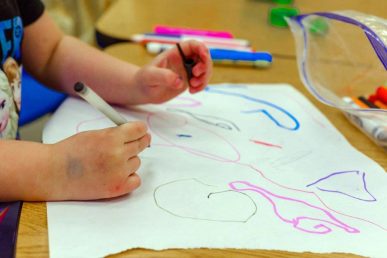Report finds fewer early childhood education expulsions following Illinois law
According to a new report from University of Illinois Chicago researchers, fewer children are being expelled now than before the passage of Illinois legislation that sought to decrease expulsions from early childhood education and child care programs and went into effect in January 2018.
The report, which covers the 2018-2019 and 2019-2020 school years, details survey responses from Illinois area early childhood professionals about their programs’ experiences with and responses to children’s challenging behaviors in the 12-month period prior to September of 2019 and 2020.
It builds on an earlier related study issued by Kate Zinsser, UIC associate professor of psychology and principal investigator at the Social-Emotional Teaching and Learning Lab, and colleagues that investigated Illinois early childhood programs’ current and prior expulsion practices, in addition to their understanding of and responses to the law.
In their original report covering the 2017-2018 school year, administrators of Illinois early childhood programs reported expelling 12.61 children per 1,000 enrolled. This new report shows that in the 2018-2019 school year, administrators reported that only 2.72 per 1,000 children enrolled were formally expelled. During the 2019-2020 school year, that rate rose slightly to 3.71 per 1,000 children registered.
“Although we cannot infer causality from these data, it is notable that far fewer children are being expelled now than before the law’s passage,” said Zinsser, lead author of the latest report. “Despite this marked improvement in formal expulsion rates, we know that children are excluded from early childhood programs in several other ways.”
In 2018-2019, nearly twice as many children who were displaying challenging behaviors were withdrawn by parents before a formal expulsion occurred as were formally expelled. Further, about three out of every 1,000 children enrolled were transitioned to another program because of their behavior. When those factors are combined, the total number of children leaving programs for behavior reasons in the 2018-2019 school year (11.37 out of every 1,000 enrolled) is nearly the same as the expulsion rate in the preceding school year before the law went into effect.
In survey results gathered from administrators, they reported on the number of children displaying challenging behaviors who left their programs via three exclusion types: those who were expelled, who transitioned into another program, and whose family voluntarily withdrew them before formal action was taken.
For each child excluded, administrators were also asked to provide child-level demographic data and details about the exclusion process. Respondents also reported on their knowledge of children’s prior experiences with adversity and completed an assessment of their understanding of the critical components of the legislation.
The survey, collected following the 2019-2020 school year, also included questions related to how the COVID-19 pandemic had impacted the programs’ enrollment, as well as access to and use of resources and supports for challenging behavior.
Some of the notable findings include:
- Boys, Black children, older children and children with diagnosed disabilities or individualized learning plans are slightly over-represented among those excluded.
- COVID-19-related closures were associated with one additional expulsion per every 1,000 children enrolled compared with the prior year.
- Even though home-based programs made up just over a quarter of the survey sample, they excluded proportionally far more children than center-based or school-based programs.
- Administrators indicated that they met with parents of 77.8% of excluded children and parent meetings happened before 100% of the reported planned transitions.
- Programs are not exhausting all mental health consultation and evaluation referral resources stipulated in the law.
- Nearly 20% of excluded children do not attend another early learning environment after their exclusion and are cared for by a relative at home after being excluded.
Based on the findings, Zinsser and colleagues recommend enhanced commitments to equity statewide that address exclusionary discipline; further clarification and support for “planned transitions” to foster consistent understanding among administrators; and prioritization of state-wide data collection and data literacy.
“Strong community partnerships and the active engagement of stakeholders at all levels of the early childhood system made this law a reality and have had an impact on policy and practice both in Illinois and nationwide,” Zinsser said. “At the same time, these data show that it is not being implemented equally well for all children and families. This law is progressive and well-intentioned but there is still a great deal of confusion surrounding it. Hopefully, these findings can help policymakers target efforts to increase access to and knowledge of supports for teachers and children during this critical developmental period.”
Co-authors of the report are H. Callie Silver, a recent UIC Ph.D. graduate in psychology, and Elyse Shenberger, UIC graduate student in psychology.
The analysis was supported by funding from the Society for the Psychological Study of Social Issues, the American Psychological Association’s Division 27 (the Society for Community Research and Action), and the UIC Office of Social Science Research.
Community partners who informed the design, analysis and interpretation of these results include Allison Lowe-Fotos of Start Early, Maria Estlund of Illinois Action for Children, and Lori Orr of the Illinois Governor’s Office of Early Childhood Development.

